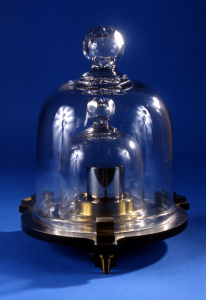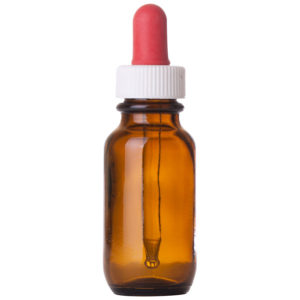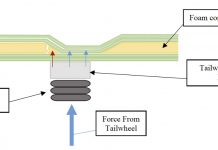The resin that we currently use in both the Glasair and the GlaStar is Dow Derakane 411-45. This resin is shipped from Stoddard-Hamilton in an unpromoted state to insure a useful shelf life for our builders. To make the resin usable, it must be promoted with a 12% solution of cobalt octoate—that’s the purple stuff. (In the past, we used cobalt napthenate, commonly referred to as “CoNap,” and some of our manuals and parts lists probably still say that. But the use of the two chemicals is the same.)
Some science
Let’s start off with a little geography. What is a meter? It is the distance from one of the poles to the equator divided by ten million. Therefore, the earth’s circumference is 40 million meters or 40,000 kilometers (x 5/8 = 25,000 miles). (A little trivia here: since a meter is a fraction of the earth’s circumference, there is a direct relationship between a nautical mile, which equals one minute of latitude, and a kilometer. One kilometer = 0.54 nautical miles. But I digress…)

What is a gram? It is the weight of a cube of water one centimeter (1/100 of a meter) on a side, hence “cc” for cubic centimeter. (Editor’s note: Yes, all you pedants out there are correct: a gram is actually a unit of mass, not of weight. However, since all Glasairs and GlaStars to date have been built here on Earth—where weight and mass are pretty much the same thing, we’ll cut Cal some slack on this one!) The cubic centimeter is, of course, also known as a milliliter, a thousand of which equal one liter. Quick now, how much does a liter of water weigh? Answer below.
But enough science—back to cooking class.
Chemistry
In addition to the cobalt promoter, an accelerator called N.N. Dimethyl Aniline, or DMA, is often added to help the resin harden in cooler climates. This is the brown or dark orange stuff.
Both cobalt and DMA should be added by weight. A gallon of resin weighs in at 3955g. For cobalt, the minimum ratio is 1 to 1,000 by weight, so therefore the minimum amount of cobalt required is 3.96g per gallon. So, that’s 3.96cc per gallon, right? Not so fast! Cobalt weighs a bit more than water, having a specific gravity of 1.04. So we can use 3.96g 4- 1.04 = 3.8cc of cobalt per gallon for minimum promotion. The maximum ratio is 1.5 to 1,000, or 5.7cc per gallon. For resin we use here in our shop, we have been using 5cc for our winter (or normal) promotion. More on the difference between minimum (summer) and maximum (winter) promotions below.
The maximum ratio for DMA is 2 to 1,000, so that would be 7.92g per gallon divided by DMA’s specific gravity of 0.956 = 8.3cc. Our experience has shown that about one third of this “maximum ratio” (or about 3cc per gallon) works well in our shop. (We rarely use the summer promotion.) Builders can vary this ratio, from adding no DMA at all for really hot climates to adding up to the maximum 8.3cc per gallon for really cold ones. A word of caution here, however: if you do use the maximum ratio and the weather warms up dramatically, you will have to work very fast!
Now for a real-world wrench in the works: the challenge of filling gallon cans with precisely 3955g of resin is beyond our present capabilities, so most cans we ship have a bit more than a gallon of resin. The one I weighed last week was 4200g. Now, I know the minimum cobalt ratio given above is a bit greater than the figure we have published previously, and with the weight of a little extra resin in each can, this raises the prospect of under-promotion of the resin. All I can say is we have been using these figures and sending out resin this way for seventeen years without any serious problems to date. We are working on improving our accuracy in this matter.
So when should you use minimum promotion versus maximum promotion? This is not an easy question to answer conclusively, since lots of things come into play here. However, temperature is the key variable, and our recommendation for shop temperatures of 65°-85° F is to use 5cc of cobalt and 3cc of DMA per gallon of resin. We call this our winter promotion, and much to our chagrin, it seems to work pretty much all year ’round here in Arlington! However, for shop temps consistently above about 80° F, we’d recommend our summer promotion, which consists of 3.8cc of cobalt per gallon and no DMA.
What happens if you use summer-promoted resin in the winter or vice versa? Well, nothing too terrible. The resin will simply kick off either really quickly or intolerably slowly. This can be controlled somewhat by the amount of catalyst you use as long as you stay within the 1% to 2.5% range discussed below.
Now comes a warning with a little explanation: do not ever mix, spill or otherwise combine cobalt and MEKP catalyst!! It is the reaction of these chemicals within the resin that starts the exothermic reaction that causes the resin to cure. The very small percentages of these two chemicals in the resin provides for a controlled reaction. But the combination of these at full strength produces lots of heat, smoke, fumes and bad vibes all around.
While I am in the warning mode and have your full attention, just another caution about MEKP. Please be very careful not to get any of this in your eyes. It will hurt you. It can impair your vision or cause blindness. Once it starts causing damage there is no known cure. So always wear eye protection when handling this material and when laminating, Use gloves, and if you happen to spill some on your bare hands, go wash them—right now. It is a good idea to cover your resin bench or area with paper; if you spill MEKP there you can simply remove all the paper (cleaning up your messy bench in the process), put this in a plastic bag, seal it up and then get rid of it. It would be most unfortunate if some unsuspecting person ran into this in your trash can and got hurt.
Another item I would urge every builder to get is an eyewash bottle to keep by his resin area. (You already have a fire extinguisher there, right?) This is just a good idea as it also works on anything else you might get in your eye—chips, dust, etc. These are available through any Safety and Supply store and most probably any first aid supplier.
And now, for catalyzation… or is it catalysis…? And now, for putting in the catalyst! We use a 50% solution of Methyl Ethyl Ketone Peroxide in Dimethyl Phthalate, or MEKP. The minimum recommendation from Dow is 1% MEKP to resin by weight, with a maximum of 2.5%. Now, once again, I know that we have been using 0.75% for our recommended minimum, and that has been successful all these years.
The specific gravity of MEKP is 1.045. Do the math, and that yields 0.96cc per 100g of resin for 1% and 2.4cc for 2.5%. You can make the conversions for other size batches from there. For batches of 50g or more, the 5cc syringes we stock are accurate enough, but for smaller batches, a narrower 1cc syringe would be a better choice. These are available at veterinary supply stores, some pharmacies or at your local needle exchange program.
Another way to measure catalyst is to use the drip-count method. I had long been providing interested builders with a chart that details how many drops per percent MEKP per gram of resin. What I did not realize is that all drops are not created equal. I did a little research and found that if I held my dropper vertically, the drops were smaller, and I got about forty drops per cc, but if I held the dropper sideways, the drops were larger, and I got about thirty per cc.
 So, what I am now recommending is that you calibrate your own dropper and make your own custom chart. What I did was take the plunger out of a 5cc syringe and plug the end. Then I counted the drops required to fill it. The first cc seemed to take more, I think because the plunger doesn’t go all the way to the bottom. So I would start at 1cc and average how much it takes to fill each cc from 2 to 5. Be sure to hold the dropper the same way you will when you are using it. By the way, the chart I had been sending out seems to have been calibrated for small drops, so use of that chart with larger drops would make the resin kick faster—not too terrible an outcome. It is also apparent that two small drops of MEKP per 5g of resin will give a 1% ratio; the maximum 2.5% works out to one small drop per gram.
So, what I am now recommending is that you calibrate your own dropper and make your own custom chart. What I did was take the plunger out of a 5cc syringe and plug the end. Then I counted the drops required to fill it. The first cc seemed to take more, I think because the plunger doesn’t go all the way to the bottom. So I would start at 1cc and average how much it takes to fill each cc from 2 to 5. Be sure to hold the dropper the same way you will when you are using it. By the way, the chart I had been sending out seems to have been calibrated for small drops, so use of that chart with larger drops would make the resin kick faster—not too terrible an outcome. It is also apparent that two small drops of MEKP per 5g of resin will give a 1% ratio; the maximum 2.5% works out to one small drop per gram.
Enough theory. Let’s get something in the oven. You have just received your resin and chemicals (cobalt, DMA and MEKP). First thing, we will promote the resin. I would suggest doing this in a wide-mouth gallon jar. This will allow you to see when the cobalt is completely mixed and will also give you a chance to find out how much resin is actually in that can. You can either weigh the jar empty and then again with resin in it or use a measuring cup to fill the jar with water and then mark where a gallon comes to (sixteen cups to a gallon). Another way would be to weigh the whole can and subtract the weight of the can—about 375g.
Let’s say you pour your resin into the jar and find you have exactly 3955g. Since temps in your workshop usually run from about 65° to 85° F, take a 5cc syringe, fill it with 5cc of cobalt and add it to your gallon of resin. Stir the resin and cobalt until completely mixed as indicated by a consistent purple color. Now, using another syringe, add 3cc of DMA and mix for the same amount of time. Pour the resin back into the can and put the cap on tightly. For getting resin out of the can for small batches and to help minimize the mess, a resin pump works nicely. Do not worry about any leftover resin in the bottom of the can as it will mix adequately with the promoted resin.
Now run a test batch. Measure out 50g of resin and catalyze it at 1%. Mix in the MEKP and stir for one minute. Let it stand, checking it every five minutes for signs of gelation. Gelation has started when the resin starts to cling to the mixing stick, gets stringy or forms a lump in the mixing cup. This should happen in about thirty minutes, give or take ten minutes. Since we left all of the resin in the cup, this test will produce the shortest gel time you can expect from this batch of resin at this temperature and percent of catalyst. You can expect longer gel times when you are laminating because there will be a smaller thermal mass. You should run this test with each gallon of resin you promote, as there are other factors for which we cannot account.
To extend the shelf life of both promoted and unpromoted resin, keep the cans tightly capped and at a cool, consistent temperature. Dow guarantees the resin for six months from when they put it in the barrel. Currently, we are going through two barrels a month, so the shortest time a builder could expect unpromoted resin to last is about five months. This would include two weeks for shipping. We are planning to begin writing the manufacture date on each can so you will know exactly what you’re getting.
Promoted resin should last one-two months (write the date you promoted it on the can) or possibly longer.
So your resin is more than two months old and your gel times are getting longer. What to do? Try re-promoting it. To do this, add one half your original quantity of promoters by volume. For example, if you have half a gallon left, add one fourth of your original promotion (1/2 x 1/2 = 1/4). You can re-promote resin twice, effectively doubling the percentage of promotion chemicals.
What about the five-month date for unpromoted resin? Well, the neat thing about vinyl ester resin is that the proof is in the pudding—i.e., if it cures, then it’s good! By “cures” I mean that it turns hard and does not have a sticky or gummy feel to it. If you have unpromoted resin that is more than five months old, I would promote it and see if it works. If you can get workable gel times and the resin cures, I would not hesitate to use it. If it has been kept capped and cool, it could last a year or more. On the other hand, if it doesn’t harden, please order some new resin and chemicals. The last thing we want you to be thinking about as you are enjoying flying your pride and joy is, “I wonder if that resin really kicked off.”
Another note: be sure to keep your MEKP, cobalt and DMA tightly capped also. If their consistency has changed from what it was when you received them, this means the carrier has evaporated and it will not be possible to get the correct percentage. Please order more.
Here are a couple of notes on controlling gel times. If your resin is kicking off too slowly you can:
- increase the catalyst up to 2.5%,
- warm up the shop,
- locally warm up the parts,
- re-promote the resin,
- put the parts in direct sunshine, or
- add more DMA.
If your resin is kicking off too fast you can:
- reduce the catalyst down to 1%,
- thin winter-promoted resin with unpromoted resin (you will have to work out the ratio so as not to drop below the 1 % value for cobalt),
- keep your resin in a cooler place (like a refrigerator with no open food),
- mix smaller batches,
- after catalyzing, pour the resin into a shallower container (this will dissipate the exothermic heat, but we’re into the desperate measures now),
- place the container of catalyzed resin on one of those food cooler ice things, or, as Cliff says,
- work faster!



